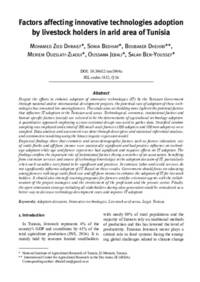Factors affecting innovative technologies adoption by livestock holders in arid area of Tunisia

Authors:
Despite the efforts to enhance adoption of innovative technologies (IT) by the Tunisian Government through national and/or international development projects, the potential rate of adoption of these technologies has remained low among farmers. This study aims at shedding some light on the potential factors that influence IT adoption in the Tunisian arid areas. Technological, economic, institutional factors and human specific factors (social) are selected to be the determinants of agricultural technology adoption. A quantitative approach employing a cross-sectional design was used to gather data. Stratified random sampling was employed and a total of 200 small-scale farmers (100 adopters and 100 non-adopters) were sampled. Data analysis and assessment was done through descriptive and statistical inferential analysis, and econometric modeling using the binary logistic regression model.
Empirical findings show that economic and socio-demographic factors such as farmer education, size of cattle flocks and off-farm income were statistically significant and had positive influence on technology adoption while age and farmer experience had significant and negative effects on IT adoption. The findings confirm the important role of institutional factors (being a member of an association, benefiting from extension services and source of technology knowledge) in the adoption decision of IT, particularly when such variables were found to be significant and positives. In contrast, labor and credit services do not significantly influence adoption of IT. Based on these results, Government should focus on educating young farmers with large cattle flock size and off-farm income to enhance the adoption of IT for livestock holders. It should also intensify training programs for farmers and for extension agents with the collaboration of the project managers and the involvement of the profession and the private sector. Finally, the open innovation strategy including all stakeholders during idea generation could be considered as a better way to decrease technology development costs and improve IT adoption.
